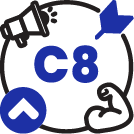Though detractors might classify MEDDIC as solely a qualification framework, only to be used by sales teams, at MEDDICC we know that to use it to its full capabilities is to use it as a common language. That common language can span the whole GTM team, at all points of the customer lifecycle.
That’s why the latest installment of our event series on MEDDIC for… the GTM team centered on Customer Success. It works so well because it focuses on the three imperatives of customer engagement: Value, Stakeholders and Process. These don’t stop being important once a deal is closed, which is why MEDDIC for Customer Success is vital!
These are the takeaways from our MEDDIC for Customer Success event.
VALUE
In Customer Success, there are many plates to keep spinning - so using MEDDPICC to keep focused on Value for your customer is crucial. That means focusing on Implicating the Pain, the Decision Criteria, and Metrics.
In our industry, we operate in a largely subscription based economy. That means that deals aren’t one-and-done - to secure renewals, you need to consistently make an impact for your customer. That means when talking about your solution, we no longer talk about BEFORE your solution vs. AFTER, but instead look at it as WITH vs. WITHOUT.
This is key to Implicating the Pain. For Customer Success, pain and its implications don’t disappear once a deal is closed. They remain until the solution solves them. What we must remember is that once the feeling of the pain goes away, it can be forgotten! Even if it’s gone away because your solution is actively working, once the pain fades, it can result in a lack of urgency when it comes to renewals.
Keep in mind: different stakeholders are affected by pain and gain differently. To maintain your solution’s relevancy for your customers, you need to consider all angles of the Pain and Gain!
As you move forward in your relationships with your customers, keeping the Decision Criteria in mind can make all the difference. You may think Decision Criteria is something for AEs, but well-defined Decision Criteria will give the post sales team unique insight into the solution that is due to be delivered complete with the rationale that led to it being implemented. Looking at the Technical, Economic, and Relationship based criteria can help you understand why you won and what the customer values. That lets you know what you need to double down on through value delivery.
Decision Criteria is what distinguishes between bad, good, and great in customer engagements. Those who think about it beyond the technical specifications, who go to the effort of educating the customer rather than just reacting to them are the ones who will make a lasting impression.
Metrics act as your north star for the post-sales team to the business value that you are aiming to deliver. We will dive into Metrics a bit later, but the most important thing to remember is that for Metrics to be effective, they need to address the Economic Buyer’s strategies and the Champion’s Initiatives.
However, while no one would argue the importance of Metrics, we still encounter some issues in establishing them. Customers often either don’t want to answer the questions needed to establish Metrics, or don’t have the data available to do so. On top of this, it frequently occurs that there is nearly always something more pressing than sitting down and determining the Metrics.
STAKEHOLDERS
Those in Customer Success are fortunate, as the key stakeholders have already been identified – it is now up to you to stay engaged with them. Making sure we know who the Champion and Economic Buyer is the first step. The next step is being aware of what has been learned about working with them. Champions get things done, and they increase your likelihood of success, especially with renewal. Since the Economic Buyer has final veto power, you need to stay engaged with them. The worst case scenario is that they will not renew, but appreciate your effort. In the best case, you’re engaged with a rainmaker!
An easy trap to fall into once a deal has closed is to forget about the Competition – but you still need to keep an eye on them as Customer Success. They aren’t going anywhere! Either internal detractors for your solution will be unsatisfied and push not to renew, or other solutions who lost the deal will come back around renewal time to try again.
PROCESS
When it comes to the Decision Process, we need to consider that it will not be the same for renewal as it was for the original deal. Learning about the Decision Process during post-sales is a great opportunity to get insights into what value delivery is needed for your customer, and what they need to take into account. It can be divided three ways: between the literal process, the people, and the timing. Understanding these three things is essential.
Keep the Paper Process in mind, because that is often where renewals tend to slip!
To maintain urgency with renewals, we need to focus on value. How do you do that? With what we at MEDDICC call an M3. To understand what an M3 is, we must first understand what an M1 and an M2 is.
An M1 uses proven and relevant value from your existing customer base to enable your prospective customer to rapidly capture an understanding of the value you provide. M1s are the ideal method to introduce your prospect to your solution via value-based proof.
An M1 then evolves into an M2 - it takes that proposed use-case and says, “Here’s how we would do it for you.” M2s can also be created without an M1 if the use case is new or is without a corresponding M1 to work from.
Once a customer agrees to work with you an M2 can be evolved into an M3 where the purpose changes from being a proposition of value to a value-based goal. While M3s will commonly evolve from M2s they can also be created as M3s if a value goal arises between you and the customer. M3s that have been achieved can then re-enter the Metrics flywheel and act as M1s for further customers!
If you are someone in Customer Success and you’re now thinking about practical ways you can implement MEDDIC, don’t worry! We’ve got some ideas for some MEDDIC x CS plays.
-
Use MEDDPICC for the world’s best handover between sales and post-sales. Knowing how you won the deal is key to continued success, and your customer will appreciate not having to answer the same questions twice.
-
Keep the Value Pyramid in mind during handover to post-sales - it keeps your customer’s priorities at the forefront of your engagements.
-
When implementing success plans, focus on Value, Stakeholders, and Process!
-
Treat churn like a competitor - and take it as seriously.
-
Understand the Decision Process – and treat it as the blueprint for renewal.
By leaning into MEDDIC, Customer Success teams can ensure thorough value delivery and secure renewals with ease. To learn more check out MEDDPICC for CS!





.png)





.png)
























%201.png)










.png)
.png)
.png)